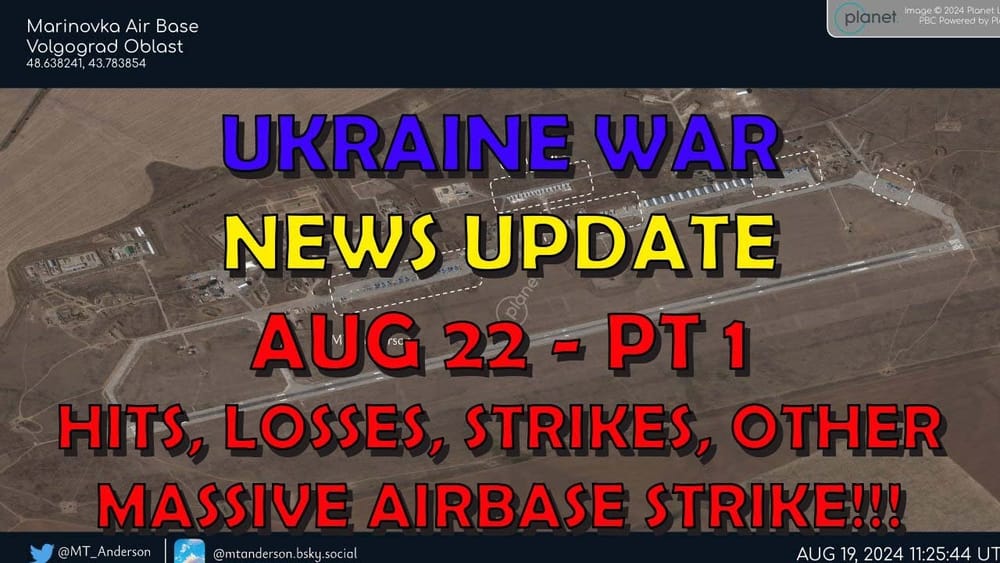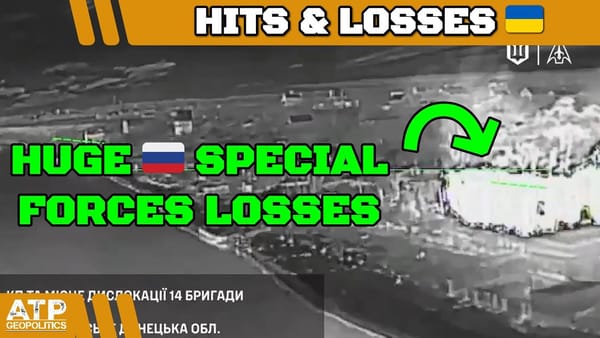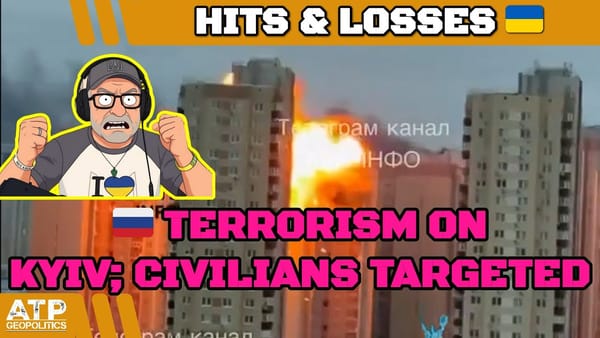Ukraine War Update BUMPER NEWS: Pt 1 - Overnight & Other News
Table of Contents 📖
"They are stockpiling. And if they are stockpiling, then I expect a massive missile attack at some point."
Hello Team
🎦 00:00-00:39⏩
Jonathan welcomes viewers to another ATP Geopolitics update on the Ukraine War, expressing a wish for a less eventful day that would allow for lighter content. However, the intensity of the conflict necessitates a focus on the ongoing events.
Return to top⤴️
🪦 DISCLAIMER FOR GENERAL STAFF LOSSES DATA
- These are real people with real lives and real families who love them. Don’t let the numbers sap your humanity.
- These numbers probably aren’t accurate but they’re the best we have and we don’t need them to be accurate to be indicative of patterns of activity.
- All losses are estimates. Losses cannot be counted with accuracy because of the conditions on the ground.
- Both sides would see it to be of their advantage to minimize their own losses maximize the other side’s losses.
- Neither side releases their losses but we have enough transparency from the Ukrainian side to have confidence in they are indicative.
- Personnel losses are hard to count. If a soldier gets injured, heals up, and returns to the front line only to get injured again, is that one loss or two? Also, how to deal with losses from PMC’s or soldiers fighting with RF from occupied territories?
- Equipment losses are hard to count. If an AA complex involves several parts and one part gets disabled, is that a loss, or a fraction of a loss? If a tank gets disabled, repaired, back into the fight, then disabled again, is that one lost tank or two?
- All recorded losses are vulnerable to multiple reporting. We have already seen numerous cases of multiple drones in the air reporting the same loss from different angles as multiple engagements.
- Losses are not always reported on the same day they occurred. It is frequent that drone losses are reported at least 24 hours after other terrestrial equipment losses. Certain losses may not be reported for days or weeks for military intelligence reasons.
Ukrainian General Staff Data: High Russian Losses
🎦 00:39-02:07⏩
Jonathan reviews the Ukrainian General Staff's figures for Russian losses, noting:
- Personnel: 1,130 (above average)
- Tanks: 7 (below average)
- Troop-carrying AFVs: 25 (above average)
- Artillery systems: 46 (over twice the daily average)
- Anti-aircraft systems: 3
- Drones: 96 (significantly high)
- Cruise Missiles: 1
- Vehicles and fuel tanks: 59 (from a previous attack)
- Special equipment: 17 (fairly high)
He acknowledges the usual caveats with this data and emphasizes the high number of drone losses, a figure he usually avoids due to reporting lags and uncertainties.
Return to top⤴️
Dell's Statistics: Seven-Day Highs in Russian Losses
🎦 02:09-05:30⏩
Jonathan highlights insights from Dell's open-source data analysis (linked in the video description):
- Seven-day highs for Russian losses in drones (57.4 average) and special equipment (13 average).
- The high drone loss (96) is the second-highest daily figure, with the highest being 115.
- Only 15 missiles were used in the same seven-day period, indicating a possible shortage in Russian missile capacity.
- Jonathan mentions an upcoming meeting with Dell and another local contact, Simon.
He praises Dell's data visualization, emphasizing the steeper trend line of Russian losses across multiple categories, particularly special equipment. He encourages viewers to explore the raw data and analysis provided by Dell.
Return to top⤴️
Propaganda Analysis: Russian Footage of Ukrainian Casualties in Kursk
🎦 06:24-08:17⏩
Jonathan addresses Russian propaganda footage depicting Ukrainian casualties in the Kursk region. He cites insights from Andrew Perpetua, who analyzes a large volume of combat footage, suggesting the footage is being misrepresented:
- The footage is standard and does not show unusually high or gruesome casualties.
- Russians are highlighting these videos to portray Ukrainian losses while overlooking their own significant losses in areas like Donetsk.
- The footage inadvertently shows Ukrainian soldiers caring for their wounded and evacuating them, contrasting with the frequent Russian practice of abandoning their wounded.
- Jonathan highlights the effectiveness of propaganda on those unfamiliar with the realities of war.
- He acknowledges Ukrainian losses in the Prokrosk direction but emphasizes the overall success of Ukrainian operations in Kursk.
Jonathan emphasizes the importance of context when interpreting such footage, highlighting the propaganda's aim to misrepresent the situation in Kursk.
Return to top⤴️
Russian Losses and Prisoner Exchanges
🎦 08:17-10:12⏩
Jonathan discusses the capture of a group of Russian soldiers, identified as belonging to the Akhmat TikTok brigade, in Kursk, contrasting this with claims of repelling Ukrainian advances made by Apteer Laudanoff, the Akhmet leader. He highlights the abundance of videos showing captured Russians, emphasizing the impact of these captures on potential prisoner exchanges, especially given the recent sentencing of Azov fighters in Russia.
Return to top⤴️
Impact of Russian Losses in Yakutsk
🎦 10:12-13:21⏩
Jonathan reports on the financial strain Russian losses are placing on certain regions, citing the Yakutsk region as an example:
- Local authorities are struggling to cover the costs of transporting the bodies of deceased soldiers back to their families.
- Crowdfunding efforts have emerged to purchase body bags and transport corpses, highlighting the lack of support from the Russian Ministry of Defence.
- Jonathan reminds viewers of the Russian practice of not recovering their dead to manipulate casualty statistics and avoid compensation payments.
- He emphasizes that reported casualty figures from specific regions likely underestimate the true extent of Russian losses.
Jonathan highlights the ethical implications of Russia's approach to its war dead, emphasizing the discrepancy between official figures and the reality on the ground.
Return to top⤴️
Alleged Friendly Fire Incident in Kursk
🎦 13:21-15:39⏩
Jonathan discusses an incident initially presented as a Ukrainian ambush on a Russian BTR-82, which later turned out to be a likely friendly fire incident between Russian BMP infantry fighting vehicles:
- He emphasizes the importance of verifying information before drawing conclusions, especially given the prevalence of misinformation surrounding such incidents.
- He acknowledges the challenges of interpreting events in a fluid and chaotic battlespace, as highlighted by the incident occurring in the heavily contested area of Raskia Konopelka in Kursk.
- He notes the increasing frequency of reported Russian friendly fire incidents.
Jonathan reminds viewers of the fog of war and the need for caution in accepting initial reports, particularly those lacking visual confirmation or originating from potentially biased sources.
Return to top⤴️
Ukrainian Counteroffensive Operations and Russian Retreats
🎦 15:40-16:32⏩
Jonathan highlights a successful Ukrainian counteroffensive operation:
- The 79th Air Assault Brigade repelled a Russian armored assault, utilizing aerial reconnaissance to detect the advancing column.
- Precise artillery fire and drone strikes neutralized the lead Russian vehicle, triggering a panicked retreat.
- Ukrainian drones effectively targeted the retreating Russian infantry.
Jonathan emphasizes the effectiveness of combined arms operations and the importance of Ukrainian drone superiority in shaping the battlespace. He notes the contrasting situations in different sectors, with Ukrainian successes in repelling Russian attacks juxtaposed with the challenging situation in Prokrosk, where the Russians are making gains.
Return to top⤴️
Effectiveness of Ukrainian HIMARS in Kursk
🎦 16:32-17:25⏩
Jonathan highlights the effectiveness of Ukrainian HIMARS systems in the Kursk region, citing reports from both Ukrainian and Russian sources:
- HIMARS strikes are significantly impacting the battlefield, forcing the Russians to acknowledge their effectiveness.
- Russian military correspondent Roman Saponkov praises the efficiency of HIMARS systems and acknowledges the complete dominance of Ukrainian unmanned systems in the region.
- The degradation of Russian air defense systems allows Ukrainian drones to operate with impunity, providing crucial intelligence for HIMARS targeting.
Jonathan emphasizes the strategic importance of degrading Russian air defenses to enable the effective use of Ukrainian drones and long-range artillery systems like HIMARS.
Return to top⤴️
Russian Forces Bombing Russian Territory in Kursk
🎦 17:30-19:15⏩
Jonathan discusses the phenomenon of Russian forces bombing areas under their control:
- Russian forces reportedly dropped 27 guided bombs on Ukrainian-held villages within the Kursk Oblast.
- He highlights the strategic implications of luring Russian forces into engaging in battles on their own territory, forcing them to destroy their own infrastructure.
- He cites this as a contributing factor to the success of the Ukrainian incursion into Kursk.
- He references Trent Tolenko's analysis of Ukrainian drone air superiority, arguing that Western armies need to adapt their doctrine and prioritize low-tech anti-aircraft defenses in response to the changing nature of warfare.
Jonathan emphasizes the strategic dilemma facing the Russians in countering Ukrainian operations within Russian territory, as any response risks further damage to their own infrastructure.
Return to top⤴️
Destruction of Russian Pontoon Crossings in Kursk
🎦 19:15-23:28⏩
Jonathan reports on the successful Ukrainian campaign to isolate Russian forces in the Glushkovsky District of Kursk:
- Ukrainian forces destroyed three pre-war bridges and two pontoon bridges across a key river, effectively trapping Russian units.
- The destruction of these bridges is attributed to HIMARS strikes, further highlighting the system's impact.
- Jonathan analyzes the geographical situation, demonstrating how the destruction of the bridges has created a logistical nightmare for Russian forces in the area.
- He links this development to the destruction of a Russian ammunition and fuel storage facility in the Kimburn Spit, suggesting it could be part of shaping operations for a potential Ukrainian offensive in the area.
Jonathan emphasizes the strategic importance of targeting Russian logistical lines and infrastructure, particularly bridges and supply depots, to disrupt their operations and isolate their forces.
Return to top⤴️
Drone Attack on Russian Military Airfield in Marinovka
🎦 24:20-30:26⏩
Jonathan details a significant drone attack on the Russian military airfield in Marinovka, located 440km from the front line:
- The attack, launched at 2:20 a.m. local time, resulted in secondary detonations, indicating successful strikes on ammunition or fuel storage.
- NASA satellites confirmed three distinct fire locations at the airfield, including areas where aircraft and fuel tanks were stored.
- Jonathan cites open-source intelligence (OSINT) analysis suggesting the presence of a significant number of aircraft at the airfield before the attack, potentially including Su-24s and Su-34s.
- He also notes the presence of large trucks that could potentially be carrying Shahed drones or other military equipment, further highlighting the significance of the attack.
Jonathan emphasizes the strategic shift in Ukrainian targeting, with a focus on degrading Russian military capabilities by striking logistical hubs, fuel depots, and ammunition storage facilities rather than solely focusing on aircraft.
Return to top⤴️
Russian Reaction and Confirmation of the Marinovka Attack
🎦 30:26-32:46⏩
Jonathan discusses the aftermath of the Marinovka airfield attack:
- He cites Russian sources confirming a fire at the military facility following the drone attack.
- Russian Governor Andriy Bucherov's claim that most drones were intercepted is contradicted by the scale of the explosions and fires.
- He includes a colorful and expletive-laden eyewitness account from a Russian local describing the ongoing explosions and fires, highlighting the severity of the attack.
Jonathan contrasts the official Russian narrative with eyewitness accounts and open-source evidence, emphasizing the credibility gap in Russian reporting on the incident. He highlights the significance of such attacks in disrupting Russian air operations and degrading their military capabilities.
Return to top⤴️
Fire at Oil Depot in Proletarsk
🎦 32:46-33:58⏩
Jonathan provides an update on the burning oil depot in Proletarsk, which was previously targeted by Ukrainian forces:
- Despite Russian efforts to extinguish the fire, which has been burning for five days, another fuel tank exploded.
- The depot, believed to be a key supplier of fuel for the Russian army, is facing significant disruptions.
Jonathan emphasizes the strategic impact of the ongoing fire on Russian military logistics and fuel supplies, potentially hindering their ability to sustain operations in the region.
Return to top⤴️
Clarification on Earlier Claims: Savaşlake Airfield and Murmansk Drone Attacks
🎦 33:58-37:34⏩
Jonathan revisits claims made in a previous breaking news segment, offering clarifications based on new information:
- He addresses claims that Ukrainian forces destroyed multiple aircraft at the Savaşlake airfield, noting that recent satellite imagery analysis by Mark Krutov does not show evidence of additional damage beyond an earlier strike.
- He acknowledges that damage could have been repaired or obscured, but emphasizes the importance of verifying such claims with concrete evidence.
- He confirms the ongoing Ukrainian drone attacks in the Murmansk region, 2,000km from Ukraine, based on video evidence showing a downed drone near the military settlement of Vizoki.
- He notes the vulnerability of Russian air defenses if Ukrainian drones can penetrate that far into Russian territory.
Jonathan emphasizes the importance of verifying information, especially in the context of an information war, and acknowledges when initial reports are contradicted by subsequent evidence.
Return to top⤴️
Increase in Ukrainian Long-Range Strikes and US Warning
🎦 37:34-39:46⏩
Jonathan analyzes the increase in Ukrainian long-range strike capability:
- He sees the recent strikes on airfields, fuel depots, and military targets deep inside Russia, including Moscow, as a sign that Ukraine is ramping up its drone production and deployment.
- He argues that overwhelming Russian air defenses with swarms of drones, as seen in recent attacks on Moscow, is a potentially effective strategy.
- He contrasts this with the limited number of missile attacks launched by Russia in recent months, suggesting a possible missile shortage.
- He shares a warning from the US Embassy in Ukraine, citing US intelligence that suggests Russia may intensify strikes on civilian infrastructure in retaliation.
Jonathan highlights the evolving nature of the conflict, with Ukraine demonstrating increasing capacity to strike deep inside Russia while Russia potentially faces limitations in its missile arsenal.
Return to top⤴️
Putin's Doubles and Russian Troop Movements
🎦 39:46-50:06⏩
Jonathan discusses a range of topics related to Russian internal affairs and troop movements:
- He revisits the topic of Putin's alleged body doubles, citing analysis by a Japanese AI firm that identified significant discrepancies in facial recognition between different appearances of Putin.
- He reports on Ukrainian cyberattacks that successfully disrupted Russian TV broadcasts, replacing propaganda with footage of the war's realities.
- He analyzes Russian troop movements, citing ISW reports that Russia is redeploying units from the eastern Donbas region to bolster defenses in Kursk, potentially weakening their offensive operations.
- He highlights the dilemma facing Putin in balancing the defense of Russian territory with maintaining offensive momentum in Ukraine.
Jonathan emphasizes the multifaceted nature of the conflict, encompassing not only military confrontations but also information warfare, cyberwarfare, and internal political pressures within Russia.
Return to top⤴️
Russian Conscripts, Refuseniks, and Treatment of Soldiers
🎦 50:06-51:23⏩
Jonathan addresses the increasing reliance on conscripts to bolster Russian defenses:
- He cites reports of poorly trained teenage conscripts being sent to Kursk, raising concerns about their effectiveness and the potential for further Russian casualties.
- He highlights growing domestic protests within Russia regarding the deployment of conscripts.
- He discusses the phenomenon of Russian "refuseniks" - soldiers refusing to fight - and the brutal treatment they face, including being handcuffed, beaten, and tortured.
- He raises the ethical and legal questions surrounding the treatment of refuseniks, particularly considering the horrific conditions and leadership failures they face.
Jonathan highlights the human cost of the war, particularly for young conscripts forced into a conflict they are ill-prepared for, and emphasizes the moral implications of Russia's treatment of its own soldiers.
Return to top⤴️
Nord Stream Pipeline Explosion and Czech President's Statement
🎦 51:23-52:09⏩
Jonathan touches upon the recent report suggesting Ukrainian involvement in the Nord Stream pipeline explosion:
- While acknowledging the lack of definitive evidence and expressing ambivalence towards the report's findings, he highlights a statement by Czech President Petr Pavel.
- Pavel, while claiming no verified information about Ukrainian involvement, states that the pipeline would have been a legitimate military target.
Jonathan uses Pavel's statement to emphasize the complexities and ambiguities surrounding the Nord Stream incident, raising questions about potential justifications for such actions within the context of the ongoing war.
Return to top⤴️
Wrap up
🎦 52:09-52:14⏩
Jonathan concludes the update, acknowledging the overwhelming amount of information covered and thanking viewers for their attention. He signs off with his usual farewells and a reminder to stay safe.
Return to top⤴️



